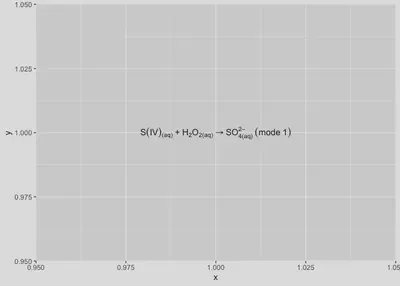Displaying Special Symbols for Equations and Reactions
2019-09-24· ·
2 min read
·
2 min read
Ka Ming FUNG
This is an example to show special characters and formats in ggplot2.
In the following example, we are going to show a chemical reaction in a plot created by “ggplot2”. It may seem straightforward but the way R handling it is not. Let’s see the codes.
library(ggplot2) # for plotting
# setting up the base plot
g = ggplot()
g = g + geom_text(aes(x = 1, y = 1, label = 'S(IV)["(aq)"]~"+"~H[2]*O[2*"(aq)"] %->% SO[4*"(aq)"]^"2–"~(mode~1)'), parse = T)
g

In the code example, we try to pass a string defined for “label” into the “R” basic function “parse” to convert plain text into an “plot.math” object, i.e., a chemical equation in this example. There are some strange symbols in the string and they all carry special function -
- round brackets “(” and “)” are quoted so that “parse” considers them normal characters.
- “~” and “*” indicate whether linking characters are separated by a space or not, respectively.
- “~” can sometimes be replaced by a space character " " if there is no ambiguity for “parse”.
- “[” and “]” are used to put the containing characters a subscript.
- “^” is used for super-scripting, and, to put multiple characters into one superscription, we need to quote the characters using quotation marks “”".
- For an expression with both sub- and superscription, “parse” considers them orderly as sub- > superscription.
- Finally, “%->%” is the arrow symbol, and a list of such special equation symbols can be found in this website of plotmath.